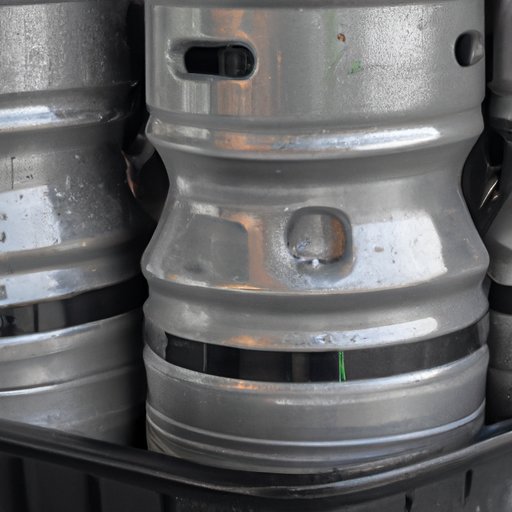Introduction
If you’ve ever been curious about kegs and how much beer they can hold, this article is perfect for you. In this comprehensive guide, we’ll explore everything you need to know about keg sizes, how many gallons are in each keg, and fun facts about kegs. We’ll also discuss different industries and events where kegs are commonly used as well as the cost-saving benefits of buying kegs.
The Ultimate Guide to Keg Sizes: How Many Gallons in each Keg?
Before we dive in, it’s important to understand that there are different types of kegs. For this guide, we’ll focus on the most commonly used kegs in the U.S. – quarter kegs, half kegs and full kegs. Quarter kegs are sometimes also referred to as pony kegs, and full kegs are known as barrels.
Quarter kegs have a capacity of 7.75 gallons, while half kegs and full kegs are 15.5 gallons and 31 gallons respectively. These three keg sizes are popular for different industries such as breweries, bars, and restaurants, as well as for special events such as weddings and parties.
There are other types of kegs, for example, the sixth barrel keg, which holds 5.17 gallons, and the Cornelius keg, which holds 5 gallons. However, these sizes are not as widely used as the ones we’ve mentioned here.
From Pints to Gallons: Understanding Beer Measurements in Kegs
Beer is measured in different ways in various countries, and kegs have different measurements in America and Britain. In the U.S., beer volume is measured in gallons, while in Britain, it’s measured in liters or hectoliters.
Fun fact: A keg’s shape was inspired by wooden barrels, which have a circular shape that allowed the barrels to be rolled instead of carried. The circular shape also allowed maximum storage while taking up minimal space.
How Much Beer Can You Get from a Keg?
Different keg sizes have varying amounts of beer. A quarter keg has 82 12-ounce pours or 62 16-ounce pours. A half keg has 165 12-ounce pours or 124 16-ounce pours, while a full keg has approximately 330 12-ounce pours or 248 16-ounce pours.
If you’re dealing with different serving sizes, it’s good to know that 1 gallon equals 128 fluid ounces, which equals approximately 11 12-ounce servings or 8 16-ounce servings. You can calculate how much beer you need using this information, but always remember that some beer may be lost during tapping or spillage.
The Cost-Saving Benefits of Buying Kegs and How to Determine the Cost per Gallon
Buying kegs instead of individual bottles or cans of beer saves money in the long run. The cost per gallon of beer from a keg is much lower than buying individual bottles or cans.
To determine the cost per gallon of beer, you need to divide the total cost of the keg by its total volume in gallons. For example, if you buy a half keg for $100, which has a volume of 15.5 gallons, the cost per gallon is $6.45. By comparison, a 6-pack of beer costing $9 for 72 fluid ounces equals approximately $20.25 per gallon.
When you buy kegs in bulk, you can save even more money. Also, there’s less waste and packaging materials.
Comparing the Gallon Capabilities of Kegs and Other Drink Containers
Growlers and bottles are other popular drink containers; however, their use is limited when it comes to serving beer in large-scale events such as weddings or parties. Kegs are more suitable in such cases.
Growlers come in different sizes, but the most common size is 64 ounces, which is equivalent to 0.5 gallons. Meanwhile, bottles typically hold 12 ounces or 22 ounces of beer. Nevertheless, growlers and bottles are popular among beer enthusiasts for small gatherings or takeaways.
Conclusion
In conclusion, kegs are a great way to store and dispense beer for both personal and commercial use. Now that you understand how many gallons are in each keg, how beer volume is measured, and the different types of kegs available, you can make an informed decision on which keg size will fit your needs perfectly.
Remember, buying kegs saves money long-term and is more environmentally friendly than buying single-use bottles or cans.
